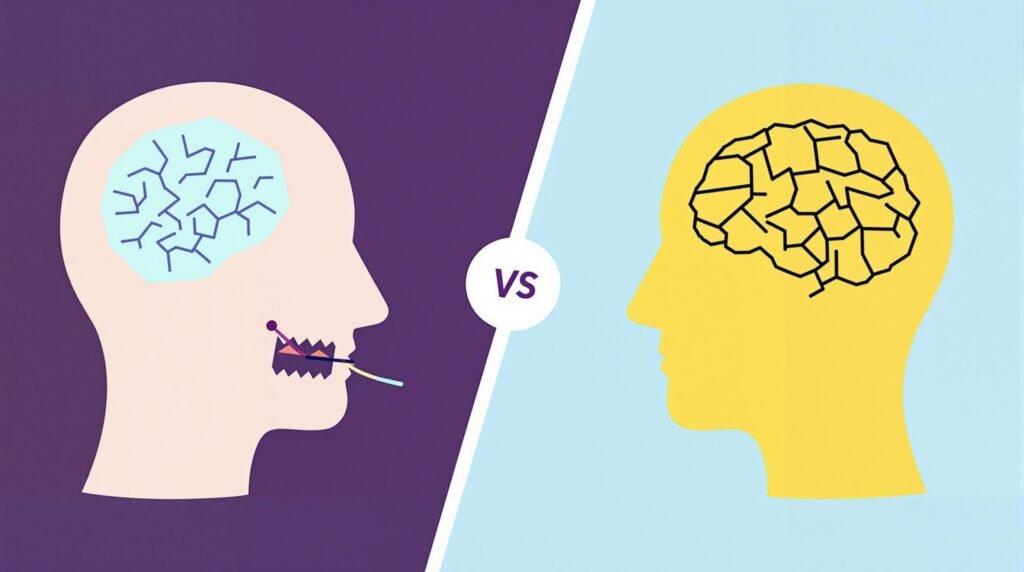Psychosis and schizophrenia are often confused or used interchangeably, but they represent different aspects of mental health disorders. Psychosis is a set of symptoms that can occur in many different conditions, while schizophrenia is a specific chronic disorder where psychosis is just one component of a more complex clinical picture.
TL;DR (Too Long; Didn’t Read)
- Psychosis is a symptom involving hallucinations and delusions that can appear in many conditions, while schizophrenia is a specific chronic disorder.
- Psychosis affects about 3.5% of people, making it three times more common than schizophrenia, which affects roughly 1% globally.
- Schizophrenia requires symptoms to persist for at least 6 months and includes negative symptoms like flat affect and social withdrawal.
- Treatment approaches differ significantly – psychosis often targets underlying causes while schizophrenia management is long-term.
- Full recovery is possible from isolated psychosis episodes, while schizophrenia is a chronic condition with fluctuating severity.
Defining the Difference: Psychosis as a Symptom vs. Schizophrenia as a Disorder
The question “are psychosis and schizophrenia the same thing?” reflects a common misunderstanding. In simple terms, psychosis is a symptom cluster rather than a standalone diagnosis. It involves a disconnection from reality, typically featuring hallucinations (seeing or hearing things that aren’t there) and delusions (fixed false beliefs). Think of psychosis like fever – it’s an indicator that something’s wrong, but not a specific illness itself.
Schizophrenia, meanwhile, is a specific chronic brain disorder characterized by persistent psychosis plus additional symptoms. These include flattened emotional responses, reduced motivation, social withdrawal, and cognitive difficulties. For a schizophrenia diagnosis, symptoms must persist for at least six months, significantly impacting a person’s ability to function in daily life.
Psychosis can appear in numerous conditions beyond schizophrenia – including bipolar disorder, severe depression, brain injuries, and substance use. I often explain to clients that while all people with schizophrenia experience psychosis, not all people who experience psychosis have schizophrenia.

How Common Are These Conditions?
Understanding the prevalence of these conditions helps put them in perspective. Psychosis affects approximately 3.5% of the general population at some point in their lives. In contrast, schizophrenia affects about 1% of people globally and around 1.2% of Americans – roughly 3.2 million people, according to the Substance Abuse and Mental Health Services Administration (SAMHSA).
This means psychosis is about three times more common than schizophrenia, reinforcing that psychosis can and does occur in many contexts outside of schizophrenia. The age of onset also differs somewhat between genders. Schizophrenia typically emerges in early adulthood, with men often showing symptoms between 18-25 years of age, while women commonly develop symptoms either between 25-30 years or around the age of 40.
Symptom Comparison: What Makes Them Different
While psychosis and schizophrenia share some symptoms, their overall clinical presentations differ significantly. Both involve what psychiatrists call “positive symptoms” – not meaning “good” but rather symptoms that add something to normal experience, such as hallucinations, delusions, and disorganized thinking.
However, schizophrenia also includes:
- Negative symptoms – reduced emotional expression, diminished motivation, social withdrawal
- Cognitive symptoms – difficulties with attention, memory, and executive functioning
- Disorganized speech and behavior
- Sometimes catatonia (unusual movements or lack of movement)
Another crucial difference lies in duration. Psychosis can be temporary or acute with no specific duration requirement. It might last hours, days, or weeks depending on the cause. Schizophrenia involves chronic dysfunction and requires symptoms for at least 6 months for proper diagnosis, according to the Merck Manuals.
What Causes These Conditions?
The causes of psychosis and schizophrenia also differ substantially. Psychosis can be triggered by various factors, including:
- Medical conditions (infections, brain injuries, tumors)
- Substance use (cannabis, LSD, methamphetamines)
- Severe stress or trauma
- Sleep deprivation
- Underlying mood disorders
Schizophrenia has a much stronger genetic component, with twin studies suggesting a 40-50% heritability rate. Environmental factors also play a role, including complications during pregnancy or birth, urban living, childhood adversity, and possibly cannabis use during adolescence.
When treating psychosis, I focus on identifying and addressing the underlying causes – which might include ruling out serious medical issues like brain tumors. Schizophrenia, however, involves lifelong neurodevelopmental abnormalities affecting brain structure and function.
The Spectrum of Psychotic Disorders
Mental health professionals recognize that psychotic disorders exist on a spectrum, with various conditions featuring psychosis as a component. These include:
- Schizophrenia: Chronic psychosis plus functional decline lasting at least 6 months
- Schizophreniform Disorder: Schizophrenia-like symptoms lasting 1-6 months
- Schizoaffective Disorder: Combined psychosis and significant mood episodes (depression or mania)
- Delusional Disorder: Non-bizarre delusions lasting at least 1 month
- Brief Psychotic Disorder: Sudden psychosis that resolves within 1 month
This spectrum approach helps clinicians provide more accurate diagnoses and appropriate treatments based on the specific presentation and duration of symptoms. It’s worth noting that someone might move between these diagnoses as their condition evolves or as more clinical information becomes available.
Treatment Approaches: Addressing Root Causes vs. Managing a Chronic Condition
Treatment approaches differ significantly between temporary psychosis and schizophrenia. For isolated psychosis, treatment typically involves antipsychotic medications like risperidone to manage acute symptoms, plus addressing the underlying cause – whether that’s treating an infection, stopping substance use, or managing a mood disorder.
Schizophrenia treatment is more comprehensive and long-term, including:
- Ongoing antipsychotic medications
- Cognitive behavioral therapy for psychosis
- Psychosocial rehabilitation
- Family education and support
- Vocational training and supported employment
Early intervention significantly improves schizophrenia prognosis but doesn’t cure it. Without appropriate treatment, psychosis can potentially develop into a more chronic condition over time, according to Charlie Health. For people experiencing first-episode psychosis, specialized early intervention programs have shown promising results in reducing future disability.
Prognosis and Recovery: Can People Get Better?
The outlook for people experiencing psychosis versus those with schizophrenia differs considerably. For isolated psychosis triggered by temporary factors like stress, drugs, or medication, full recovery is often possible once the underlying cause is addressed.
Schizophrenia, being a chronic condition, typically follows a pattern of fluctuating severity throughout life. However, contrary to some outdated beliefs, people with schizophrenia can and do improve. According to Mental Health America, approximately 20-30% of people with schizophrenia achieve significant functional improvement with proper treatment.
Relapse rates also differ markedly. Without medication, schizophrenia has relapse rates exceeding 80%, compared to much lower rates for isolated psychosis episodes. With a comprehensive treatment approach that includes medication, therapy, social support, and lifestyle management, many people with schizophrenia can lead fulfilling lives despite their diagnosis.
Sources
Charlie Health – Psychosis vs Schizophrenia
Merck Manuals – Schizophrenia
SAMHSA – Schizophrenia
Mental Health America – Psychosis
Talkspace – Psychosis vs Schizophrenia



